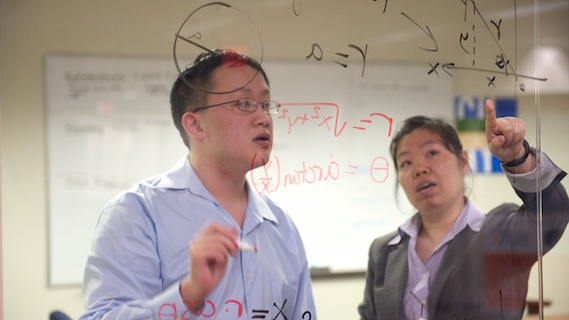
While visiting museums in Manhattan a few years ago, BMCC mathematics professor Lina Wu couldn’t help noticing that much of the artwork incorporated geometric shapes and patterns. The experience confirmed what she had long suspected—that equations, formulas and mathematical calculations often figure in the creation of art.
And that gave her an idea.
“Anyone who has taught calculus knows that making it interesting to students can be a challenge,” Wu says.
“You need to present the material in a way that inspires students to learn more and helps them develop their problem-solving skills. It shouldn’t be just about memorizing formulas and equations.”
Not only do students find rote memorization boring, she says, “they also question its relevance to their lives.”
The irony is that virtually every aspect of daily life involves math. “It’s important to me that they see that—and also that I find a way to convey the beauty of math to them,” she says
Steep learning curve
Wu had emigrated to the U.S. from China in 2000 to pursue a PhD in mathematics at the University of Oklahoma. Later, after a five-year teaching stint in Ohio at the University of Toledo, she moved to New York to join her husband, who was working for the Department of Homeland Security. She joined BMCC in 2011.
In her Calculus I class this academic year, Wu led her students through the intricacies of polar equations—a branch of analytical geometry that can take even math majors into unfamiliar territory.
“There are many different polar equations and students in Calculus I are expected to be able to understand how they work and how to use them to generate different curves,” says Wu. “It’s not easy.”
But it could be fun, she decided. So she designed a project that would help her students understand and take pleasure in the connection between math and art.
She organized the class into groups of four students, assigning each group to create a beautiful art picture using at least four different polar equations and four colors.
“Each image was to have a title, and correspond to a month of the year,” says Wu. “And each should relate in some way to their lives as college students.”
A graph is a rose is a rose
“At first I thought this was going to be almost impossible,” says mathematics major Howie Terence Shi.
“But as I played with the idea, I saw that it could work.” Like the others in his group, Shin struggled to create recognizable images, trying out endless combinations of polar equations and variables. Working in the Math Lab and using a specialized software program, he eventually constructed polar graphs of a rose and a snow angel.
“Everyone in our group came up with at least one polar image,” says Shi. “The next step was to combine two or more into a really terrific image. It was hard to envision how we might accomplish that, but we kept at it—it was totally a group effort.”
High-level math, he adds, is best approached collaboratively.
“Being in a group always helps. Invariably there are advanced students who take to it more readily and those who have more trouble keeping up, but everyone wants to succeed, and everyone works together.”
As their teacher, guide and cheerleader, Wu helped make a tough assignment enjoyable, Shin says. “I’d taken other classes with Prof. Wu, and her approach is to get everyone involved in the subject and then acclimated to new ways of thinking about it.”
The year of learning creatively
Ultimately, the images produced by the class were assembled into a colorful and visually striking 12-month calendar; July is illustrated by the rose image that Shi’s group created, which is captioned “Polar Rose Representing Our Love for BMCC.”
Viewed together, the calendar’s 12 images offer compelling proof of Wu’s belief in the close relationship between math and art.
Wu says she may repurpose the same assignment in future Calculus classes—but maybe not immediately.
“I love the challenge of teaching math in a creative way,” she says. “So I’m more inclined to try something new.”
STORY HIGHLIGHTS
- Devises creative ways to engage students in a challenging subject
- Math lab assignment explores links between art and math
- I am always looking for new ways to teach

